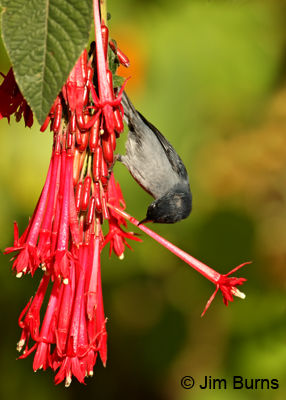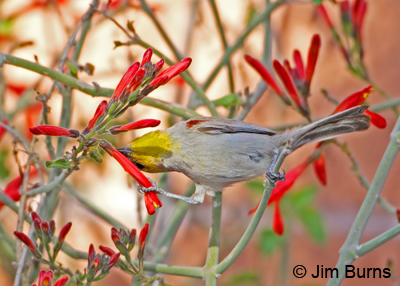
This past winter on our trip to Costa Rica, where everything was new and different, one of our unanticipated surprises was observing a small dark bird flip down onto a spectacular red tubular flower, quite deliberately grasp one corolla with its foot, pull it down within reach, then pierce the base with its beak and extract nectar. Hummingbirds were everywhere, but this was a non-hummer species beating the nectar specialists at their own game. How cool was that! A quick perusal of our Costa Rican guide book told us just how aptly this species was named—Slaty Flowerpiercer. My photographs showed a tiny hook at the tip of the upper mandible, obviously evolved to pierce the base of flower petals.
Now fast forward to yesterday in our garden when a Verdin came to a bed of Chuparosa planted specifically because its red tubular flowers are known to be a hummingbird favorite. Even casual birders in the southwest know the Verdin, the flighty little gray job with the yellow head and the chestnut epaulettes, usually seen flipping from bush to bush gleaning small insects from the foliage with its tiny, sharply pointed bill.
Verdins aren't shy, their rather monotonous three syllable call is easily recognized, and most birders don't even raise their binoculars when one is nearby and can be identified with the naked eye. Yesterday, involuntarily, I raised my binoculars to check out the Verdin in our Chuparosa. Guess what it was doing? it was balancing on a stalk with one foot, clutching the base of the nearest Chuparosa corolla with the other foot, pulling the whole bloom down to within reach, then piercing the base with its bill. Verdins take nectar!?
All the field guides I have either say that Verdins glean insects or don't mention food preference for this species at all. I certainly had never noticed a Verdin channeling its inner flowerpiercer like this, so I checked it out in"The Bible," Birds Of North America.Right there under "Food Habits" is a great little line drawing of a Verdin clutching a Chuparosa blossom with one foot with the title "A Verdin feeding on nectar from a Chuparosa flower." Who knew? Obviously not me.
Birds need to eat. Birders need to observe. Species fill niches wherever food can be found. Birders check all possible references for information. Why wouldn't two distinct species, continents apart, evolve to fill the same type of environmental niche? Why wouldn't birders want to be as knowledgeable as possible about the objects of their avocation?